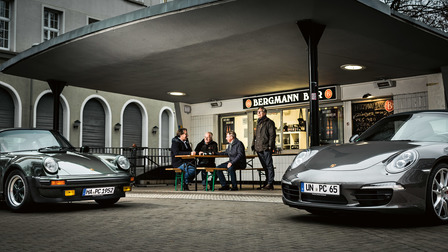
Homeland
Founded: May 26, 1952
Members: 55
President: Dr. Karsten Schumann
Official club number: 1
Over eighty-five countries are home to 675
“Deep in the West, where the sun sinks in dust …” is how the famous song “Bochum” by Herbert Grönemeyer begins. It pays homage not only to his hometown of Bochum, with its “pulse of steel,” but also to the Ruhr district and its people. Coal, beer, steel—a triad that shaped the region and made cities like Essen, Bochum, and Dortmund great. They’re melting pots whose residents are as proud of their home as they are of their reputation for hard work.
The Hansa coking plant in the western part of Dortmund is a landmark from this era. It used to be the largest of such plants in the area, producing nearly two million tons of coke per year, before it was finally shut down in 1992. And yet it still embodies the spirit of the age. A convoy of lovingly maintained sports cars slowly approaches the deserted furnaces and machine halls—a
![[+]](https://staging.www.porsche.com/filestore/image/multimedia/none/christophorus-issue381-article02-content-01/normal/37f9f66e-193e-11e7-9f74-0019999cd470/porsche-normal.jpg)
Heirloom: The first “Club Champion” plate from 1953—a carefully preserved treasure with a high collector’s value.
The largest area of urban sprawl in Europe underwent radical changes after World War II. The mining and steel industries gradually faded in importance. “Coal was the first to go, followed by steel—and then beer,” recalls Reiner Kötter, a wholesale beverage dealer and the club’s president until 2014. He can’t hide the melancholy in his voice and on his face. As Germany’s economic miracle picked up steam after the war, the Westphalian
Little by little, however, the “coal shed of the nation” turned into a hub for the service industry, education, and culture. This transformation brought fresh energy into the region and invigorated the club.
“We’re a bunch of nuts,” says Schumann. A physician and father, he recognizes the club’s history but emphasizes its dynamic side. “The club lives from its members. Tradition is all well and good, but what drives this type of organization is people’s commitment.” The club currently has around fifty-five
“Members used to sit around for cake and coffee on the weekends, but that’s changed over the years,” Boris Jankiewicz, the vice president, recalls. Although they do still hold some evening events, these
Letter and seal: This 1965 letter signed by Ferry
Christian Wälzholz, an entrepreneur, is a good example: sociable and quick on the uptake, like the Ruhr district itself, with an affinity for individuals who don’t necessarily wear their hearts on their sleeves. Three of the club members are also in
When businessman Joachim Bade, now fifty years old, talks about his enthusiasm for
By Lars Zwickies
Photos by Thorsten Doerk
Fritz Henßler Haus
Automotive dealer Jörg Stoye and his car stand outside the Fritz Henßler Haus, otherwise known as the “Haus der Jugend” (Youth Center), built in 1955/56. It’s still used by adolescents and as a stage for cultural newcomers.
Model: 911
Engine: 3.6-liter six-cylinder
Power: 202.8 kW (272 hp)
Color: Iris Blue
Freizeitzentrum West
The former industrial area behind the Freizeitzentrum West (Recreational Center West), near the old Union Brewery, is being rejuvenated by a subculture of street art and young creatives. Entrepreneur Christian Wälzholz and his
Model:
Engine: 3.6-liter six-cylinder
Power: 279.6 kW (375 hp)
Color: Guards Red
Dortmund Concert Hall
Presidential flair in the inner city: President Karsten Schumann and his
Model: 911
Engine: 3.8-liter six-cylinder
Power: 320.7 kW (430 hp)
Color: Rhodium Silver
Hansa coking plant
Vice President Boris Jankiewicz and his
Model: 911
Engine: 3.2-liter six-cylinder
Power: 172.3 kW (231 hp)
Color: Grand Prix White
![[+]](https://staging.www.porsche.com/filestore/image/multimedia/none/christophorus-issue381-article02-margin-01/normal/73dd3beb-193d-11e7-9f74-0019999cd470/porsche-normal.jpg)
![[+]](https://staging.www.porsche.com/filestore/image/multimedia/none/christophorus-issue381-article02-margin-02/normal/79334511-1ab4-11e7-9f74-0019999cd470/porsche-normal.jpg)
![[+]](https://staging.www.porsche.com/filestore/image/multimedia/none/christophorus-issue381-article02-margin-03/normal/a32fd138-193e-11e7-9f74-0019999cd470/porsche-normal.jpg)
![[+]](https://staging.www.porsche.com/filestore/image/multimedia/none/christophorus-issue381-article02-margin-04/normal/cc478aa7-193f-11e7-9f74-0019999cd470/porsche-normal.jpg)
![[+]](https://staging.www.porsche.com/filestore/image/multimedia/none/christophorus-issue381-article02-margin-05/normal/d2da798b-193f-11e7-9f74-0019999cd470/porsche-normal.jpg)
![[+]](https://staging.www.porsche.com/filestore/image/multimedia/none/christophorus-issue381-article02-margin-06/normal/dccb1b97-193f-11e7-9f74-0019999cd470/porsche-normal.jpg)
![[+]](https://staging.www.porsche.com/filestore/image/multimedia/none/christophorus-issue381-article02-margin-07/normal/e49f64a1-193f-11e7-9f74-0019999cd470/porsche-normal.jpg)









